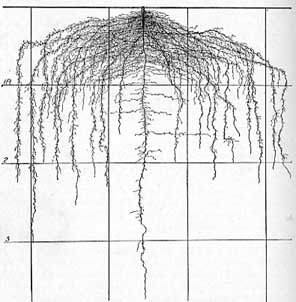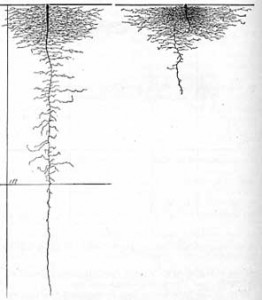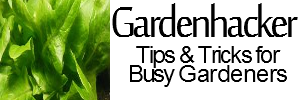 There is a wonderful reference in the public domain regarding plant roots. Written in 1927, this book illustrates the root growth of many vegetables in a variety of conditions. sustainablefarmer.com has made this book available online at http://www.sustainablefarmer.com/pdflibrary/library-rootdevelopment.pdf. While the book focuses on the locale of Lincoln, NE and Norman, OK – it’s information is notworthy for any gardener.
There is a wonderful reference in the public domain regarding plant roots. Written in 1927, this book illustrates the root growth of many vegetables in a variety of conditions. sustainablefarmer.com has made this book available online at http://www.sustainablefarmer.com/pdflibrary/library-rootdevelopment.pdf. While the book focuses on the locale of Lincoln, NE and Norman, OK – it’s information is notworthy for any gardener.
Topics include:
- Modifying the root environment
- Adaptation of roots to environment
- Root adaptation and crop production
- Interrelations of plant, soil, and climate
- Activities of roots in subsoil
- Number and size of plants
- Tillage
- etc.

The difference between aerated soil and compacted soil on a lettuce plant illustrates the need for pathways between rows of plants, and why you shouldn’t be stepping into the beds to reach that plant that’s just a little too far away.
Some of the plants covered in this book include
- Leeks
- Garlic
- Asparagus
- Rhubarb
- Beet
- Chard
- Spinach
- Strawberry
- Carrots
and many more. I’ve picked out my favorites to study their habits and printed them out for perusing over morning coffee when I’m not doing scrimshaw so I can better plan the garden plots. I am curious – though not curious enough to do forensic digging at the end of the season – to find out if these plants will reach out to the adjacent pathways of bark mulch layed out this year, or if they reach to – or through – the logs buried in the hugelkultur beds. These illustrations also raise questions about the use of plastic for wicking beds beneath the complete bed, or if the plants would be better served by putting these reservoirs along the periphery, perhaps along the non-growing pathways between the rows.
Asparagus is my favorite perennial. If budget allows, we’re planning on moving our bed to a sunnier area on the side of a hill. By the looks of the root systems and reading of the length and depth the root systems reach, the lion’s share of the manure collected from our local stables will be going to these plants, and heavy mulching will be in order as well to sustain the nutrients. Cutting down the dead stalks at the end of the season and composting them elsewhere appears to be a habit not to be continued, as the stalks hold the snow to the plant’s benifit – regulating the soil temperature well into the growing season (pg 46).
In chapter 30 about muskmelons (which would include cantaloupe and other melons of this variety) it appears that planting them in the center of the row with ample room for the roots to grow in all directions would be the best solution. These do not appear to be conducive to the square foot gardening method, though planting companion plants thinly around them could be to their benefit. Successive planting in a wider and wider circle around the central plant seems a good idea, with Nasturtiums, radishes, marigolds, sunflowers, peas, beets, carrots, and dill being the best companions for their close cousin the cucumber. Peas would also give back nutrients when cut down, marigolds driving away bugs.
Newspaper, Pennies, Cardboard, and Eggs–For Growing a Better Garden
Pay Dirt: How To Make 10,000 a Year From Your Backyard Garden








[…] Hidden World of Plant Roots disease […]